Activated Carbon Preparation from Sugarcane Leaf via a Low Temperature Hydrothermal Process for Aquaponic Treatment
Abstract
:1. Introduction
2. Materials and Methods
2.1. The Production of Sugarcane Leaf-Activated Carbon
2.2. Characteristics of Sugarcane Leaf and Sugarcane Leaf Activated Carbon
2.3. Using the Sugarcane Leaf Activated Carbon for Aquaponic Treatment
- Aquaculture system (pond 1) without a hydroponics system for control experiment (Figure 1a)
- Hydroponic system without aquaculture system (Figure 1b)
- Aquaponics system (pond 2 and hydroponic system) without activated carbon filter (Figure 1c)
- Aquaponics system (pond 3 and hydroponic system) with 3 kg activated carbon filter (Figure 1d)
2.4. Water Analysis
3. Results and Discussion
3.1. Percent Yield
3.2. Elemental Composition from EDS
3.3. FTIR Spectrum of Pyrolyzed Products
3.4. XRD Diffractogram of Pyrolyzed Products
3.5. Zeta Potential of Pyrolyzed 0–1% KMnO4 Pre-Hydrothermal Products
3.6. Morphologies of Pyrolyzed Products
3.7. Surface Characteristic of Sugarcane Leaf Activated Carbon
3.8. The Results of Water Analysis
3.8.1. pH of Water
3.8.2. Dissolved Oxygen in Water
3.9. Growth of Fish and Plants
4. Conclusions
Author Contributions
Funding
Institutional Review Board Statement
Informed Consent Statement
Data Availability Statement
Acknowledgments
Conflicts of Interest
References
- Benstoem, F.; Becker, G.; Firk, J.; Kaless, M.; Wuest, D.; Pinnekamp, J.; Kruse, A. Elimination of micropollutants by activated carbon produced from fibers taken from wastewater screenings using hydrothermal carbonization. J. Environ. Manag. 2018, 211, 278–286. [Google Scholar] [CrossRef] [PubMed]
- Mbarki, F.; Selmi, T.; Kesraoui, A.; Seffen, M.; Gadonneix, P.; Celzard, A.; Fierro, V. Hydrothermal pre-treatment, an efficient tool to improve activated carbon performances. Ind. Crops Prod. 2019, 140, 111717. [Google Scholar] [CrossRef] [Green Version]
- Sun, G.; Qiu, L.; Zhu, M.; Kang, K.; Guo, X. Activated carbons prepared by hydrothermal pretreatment and chemical activation of Eucommia ulmoides wood for supercapacitors application. Ind. Crops Prod. 2018, 125, 41–49. [Google Scholar] [CrossRef]
- Khan, T.A.; Saud, A.S.; Jamari, S.S.; Rahim, M.H.A.; Park, J.-W.; Kim, H.-J. Hydrothermal carbonization of lignocellulosic biomass for carbon rich material preparation: A review. Biomass Bioenergy 2019, 130, 105384. [Google Scholar] [CrossRef]
- Wilk, M.; Magdziarz, A.; Kalemba-Rec, I.; Szymańska-Chargot, M. Upgrading of green waste into carbon-rich solid biofuel by hydrothermal carbonization: The effect of process parameters on hydrochar derived from acacia. Energy 2020, 202, 117717. [Google Scholar] [CrossRef]
- Wang, B.; Zhai, Y.; Wang, T.; Li, S.; Peng, C.; Wang, Z.; Li, C.; Xu, B. Fabrication of bean dreg-derived carbon with high adsorption for methylene blue: Effect of hydrothermal pretreatment and pyrolysis process. Bioresour. Technol. 2019, 274, 525–532. [Google Scholar] [CrossRef] [PubMed]
- Pari, G.; Darmawan, S.; Prihandoko, B. Porous carbon spheres from hydrothermal carbonization and KOH activation on cassava and tapioca flour raw material. Procedia Environ. Sci. 2014, 20, 342–351. [Google Scholar] [CrossRef] [Green Version]
- Selmi, T.; Sanchez, A.; Gadonneix, P.; Jagiello, J.; Seffen, M.; Sammouda, H.; Celzard, A.; Fierro, V. Tetracycline removal with activated carbons produced by hydrothermal carbonisation of Agave americana fibres and mimosa tannin. Ind. Crops Prod. 2018, 115, 146–157. [Google Scholar] [CrossRef]
- Su, Y.; Liu, L.; Xu, D.; Du, H.; Xie, Y.; Xiong, Y.; Zhang, S. Syngas production at low temperature via the combination of hydrothermal pretreatment and activated carbon catalyst along with value-added utilization of tar and bio-char. Energy Convers. Manag. 2020, 205, 112382. [Google Scholar] [CrossRef]
- Aguiar, A.; Milessi, T.S.; Mulinari, D.R.; Lopes, M.S.; Costa, S.M.; Candido, R.G. Sugarcane straw as a potential second generation feedstock for biorefinery and white biotechnology applications. Biomass Bioenergy 2021, 144, 105896. [Google Scholar] [CrossRef]
- Arumugam, A.; Sankaranarayanan, P. Biodiesel production and parameter optimization: An approach to utilize residual ash from sugarcane leaf, a novel heterogeneous catalyst, from Calophyllum inophyllum oil. Renew Energy 2020, 153, 1272–1282. [Google Scholar] [CrossRef]
- Yadav, S.K.J.; Vedrtnam, A.; Gunwant, D. Experimental and numerical study on mechanical behavior and resistance to natural weathering of sugarcane leave reinforced polymer composite. Constr. Build. Mater. 2020, 262, 120785. [Google Scholar] [CrossRef]
- Kyaw, T.Y.; Ng, A.K. Smart aquaponics system for urban farming. Energy Procedia 2017, 143, 342–347. [Google Scholar] [CrossRef]
- Khiari, Z.; Alka, K.; Kelloway, S.; Mason, B.; Savidov, N. Integration of Biochar Filtration into Aquaponics: Effects on Particle Size Distribution and Turbidity Removal. Agric. Water Manag. 2020, 229, 105874. [Google Scholar] [CrossRef]
- Pous, N.; Korth, B.; Alvarez, M.O.; Balaguer, M.D.; Harnisch, F.; Puig, S. Electrifying biotrickling filters for the treatment of aquaponics wastewater. Bioresour. Technol. 2021, 319, 124221. [Google Scholar] [CrossRef]
- Bhakar, V.; Kaur, K.; Singh, H. Analyzing the Environmental Burden of an Aquaponics System using LCA. Procedia CIRP 2021, 98, 223–228. [Google Scholar] [CrossRef]
- Pérez-Urrestarazu, L.; Lobillo-Eguíbar, J.; Fernández-Cañero, R.; Fernández-Cabanás, V.M. Suitability and optimization of FAO’s small-scale aquaponics systems for joint production of lettuce (Lactuca sativa) and fish (Carassius auratus). Aquac. Eng. 2019, 85, 129–137. [Google Scholar] [CrossRef]
- Tůmová, V.; Klímová, A.; Kalous, L. Status quo of commercial aquaculture in Czechia: A misleading public image? Aquac. Rep. 2020, 18, 100508. [Google Scholar] [CrossRef]
- Mori, J.; Smith, R. Transmission of waterborne fish and plant pathogens in aquaponics and their control with physical disinfection and filtration: A systematized review. Aquaculture 2019, 504, 380–395. [Google Scholar] [CrossRef]
- Suhl, J.; Dannehl, D.; Baganz, D.; Schmidt, U.; Kloas, W. An innovative suction filter device reduces nitrogen loss in double recirculating aquaponic systems. Aquac. Eng. 2018, 82, 63–72. [Google Scholar] [CrossRef]
- Tejido-Nuñez, Y.; Aymerich, E.; Sancho, L.; Refard, D. Co-cultivation of microalgae in aquaculture water: Interactions, growth and nutrient removal efficiency at laboratory- and pilot-scale. Ecol. Eng. 2019, 136, 1–9. [Google Scholar] [CrossRef]
- Yena, H.Y.; Chou, J.H. Water purification by oyster shell bio-medium in a recirculating aquaponic system. Ecol. Eng. 2016, 95, 229–236. [Google Scholar] [CrossRef]
- Li, G.; Tao, L.; Li, X.; Peng, L.; Song, C.; Dai, L.; Wu, Y.; Xie, L. Design and performance of a novel rice hydroponic biofilter in a pond-scale aquaponic recirculating system. Ecol. Eng. 2018, 125, 1–10. [Google Scholar] [CrossRef]
- Effendi, H.; Widyatmoko; Utomo, B.A.; Pratiwi, N.T.M. Ammonia and orthophosphate removal of tilapia cultivation wastewater with Vetiveria zizanioides. J. King Saud Univ. Sci. 2020, 32, 207–212. [Google Scholar] [CrossRef]
- Mahat, N.A.; Aisyah Shamsudin, S.A. Transformation of oil palm biomass to optical carbon quantum dots by carbonisation-activation and low temperature hydrothermal processes. Diam. Relat. Mater. 2020, 102, 107660. [Google Scholar] [CrossRef]
- Carpenter, J.H. The Chesapeake bay institute technique for the Winkler dissolved oxygen method. Limnol. Oceanogr. 1965, 10, 141–143. [Google Scholar] [CrossRef]
- Iradukunda, Y.; Wang, G.; Li, X.; Shi, G.; Hu, Y.; Luo, F.; Yi, K.; Ismail, A.; Albashir, M.; Niu, X.; et al. High performance of activated carbons prepared from mangosteen (Garcinia mangostana) peels using the hydrothermal process. J. Energy Storage. 2021, 39, 102577. [Google Scholar] [CrossRef]
- Dessie, Y.; Tadesse, S.; Eswaramoorthy, R. Physicochemical parameter influences and their optimization on the biosynthesis of MnO2 nanoparticles using Vernonia amygdalina leaf extract. Arab. J. Chem. 2020, 13, 6472–6492. [Google Scholar] [CrossRef]
- Pan, Z.; Li, Y.; Wang, B.; Sun, F.; Xu, F.; Zhang, X. Mild fractionation of poplar into reactive lignin via lignin-first strategy and its enhancement on cellulose saccharification. Bioresour. Technol. 2022, 343, 126122. [Google Scholar] [CrossRef]
- Goydaragh, M.G.; Taghizadeh-Mehrjardi, R.; Golchin, A.; Jafarzadeh, A.A.; Lado, M. Predicting weathering indices in soils using FTIR spectra and random forest models. Catena 2021, 204, 105437. [Google Scholar] [CrossRef]
- Ying, D.; Hong, P.; Jiali, F.; Qinqin, T.; Yuhui, L.; Youqun, W.; Zhibin, Z.; Xiaohong, C.; Yunhai, L. Removal of uranium using MnO2/orange peel biochar composite prepared by activation and in-situ deposit in a single step. Biomass Bioenergy 2020, 142, 105772. [Google Scholar] [CrossRef]
- Li, C.; Sun, Y.; Yi, Z.; Zhang, L.; Zhang, S.; Hu, X. Co-pyrolysis of coke bottle wastes with cellulose, lignin and sawdust: Impacts of the mixed feedstock on char properties. Renew Energy 2022, 181, 1126–1139. [Google Scholar] [CrossRef]
- Istadi, I.; Prasetyo, S.A.; Nugroho, T.S. Characterization of K2O/CaO-ZnO catalyst for transesterification of soybean oil to biodiesel. Procedia Environ. Sci. 2015, 23, 394–399. [Google Scholar] [CrossRef] [Green Version]
- Maršálek, R.; Švidrnoch, M. The adsorption of amitriptyline and nortriptyline on activated carbon, diosmectite and titanium dioxide. Environ. Chall. 2020, 1, 100005. [Google Scholar] [CrossRef]
- Li, L.; Li, Y.; Tan, C.; Zhang, T.; Xin, X.; Li, W.; Li, J.; Lu, R. Study of the interaction mechanism between GO/rGO and trypsin. J. Hazard. Mater. Adv. 2021, 3, 100011. [Google Scholar] [CrossRef]
- Zhuang, Y.; Liu, J.; Chen, J.; Fei, P. Modified pineapple bran cellulose by potassium permanganate as a copper ion adsorbent and its adsorption kinetic and adsorption thermodynamic. Food Bioprod. Process. 2020, 122, 82–88. [Google Scholar] [CrossRef]
- Zerveas, S.; Mente, M.S.; Tsakiri, D.; Kotzabasis, K. Microalgal photosynthesis induces alkalization of aquatic environment as a result of H+ uptake independently from CO2 concentration-New perspectives for environmental applications. J. Environ. Manag. 2021, 289, 112546. [Google Scholar] [CrossRef] [PubMed]
- Nahar, K.; Hoque, S. Phytoremediation to improve eutrophic ecosystem by the floating aquatic macrophyte, water lettuce (Pistia stratiotes L.) at lab scale. Egypt. J. Aquat. Res. 2021, 47, 231–237. [Google Scholar] [CrossRef]
- Li, F.; Sun, Z.; Qi, H.; Zhou, X.; Xu, C.; Wu, D.; Fang, F.; Feng, J.; Zhang, N. Effects of rice-fish co-culture on oxygen consumption in intensive aquaculture pond. Rice Sci. 2019, 26, 50–59. [Google Scholar] [CrossRef]
- Hossain, M.A.; Hossain, M.A.; Haque, M.A.; Mondol, M.M.R.; Harun-Ur-Rashid, M.; Das, S.K. Determination of suitable stocking density for good aquaculture practice-based carp fattening in ponds under drought-prone areas of Bangladesh. Aquaculture 2022, 547, 737485. [Google Scholar] [CrossRef]
- Schuijt, L.M.; van Bergen, T.J.H.M.; Lamers, L.P.M.; Smolders, A.J.P.; Verdonschot, P.F.M. Aquatic worms (Tubificidae) facilitate productivity of macrophyte Azolla filiculoides in a wastewater biocascade system. Sci. Total Environ. 2021, 787, 147538. [Google Scholar] [CrossRef]
- Belaïdi, F.S.; Salvagnac, L.; Souleille, S.A.; Blatché, M.C.; Bedel-Pereira, E.; Séguy, I.; Launay, J. Accurate physiological monitoring using lab-on-a-chip platform for aquatic micro-organisms growth and optimized culture. Sens. Actuators B Chem. 2020, 321, 128492. [Google Scholar] [CrossRef]
- Cunha, M.E.; Quental-Ferreira, H.; Parejo, A.; Gamito, S.; Ribeiro, L.; Moreira, M.; Monteiro, I.; Soares, F.; Pousão-Ferreira, P. Understanding the individual role of fish, oyster, phytoplankton and macroalgae in the ecology of integrated production in earthen ponds. Aquaculture 2019, 512, 734297. [Google Scholar] [CrossRef]
- Rawles, S.D.; Green, B.W.; Mc Entire, M.E.; Gibson Gaylord, T.G.; Barrows, F.T. Reducing dietary protein in pond production of hybrid striped bass (Morone chrysops × M. saxatilis): Effects on fish performance and water quality dynamics. Aquaculture 2018, 490, 217–227. [Google Scholar] [CrossRef]
- Liu, H.; Li, H.; Wei, H.; Zhu, X.; Han, D.; Jin, J.; Yang, Y.; Xie, S. Biofloc formation improves water quality and fish yield in a freshwater pond aquaculture system. Aquaculture 2019, 506, 256–269. [Google Scholar] [CrossRef]
- Hoess, R.; Geist, J. Nutrient and fine sediment loading from fish pond drainage to pearl mussel streams-Management implications for highly valuable stream ecosystems. J. Environ. Manag. Part A 2022, 302, 113987. [Google Scholar] [CrossRef]
- Paudel, S.R. Nitrogen transformation in engineered aquaponics with water celery (Oenanthe javanica) and koi carp (Cyprinus carpio): Effects of plant to fish biomass ratio. Aquaculture 2020, 520, 734971. [Google Scholar] [CrossRef]



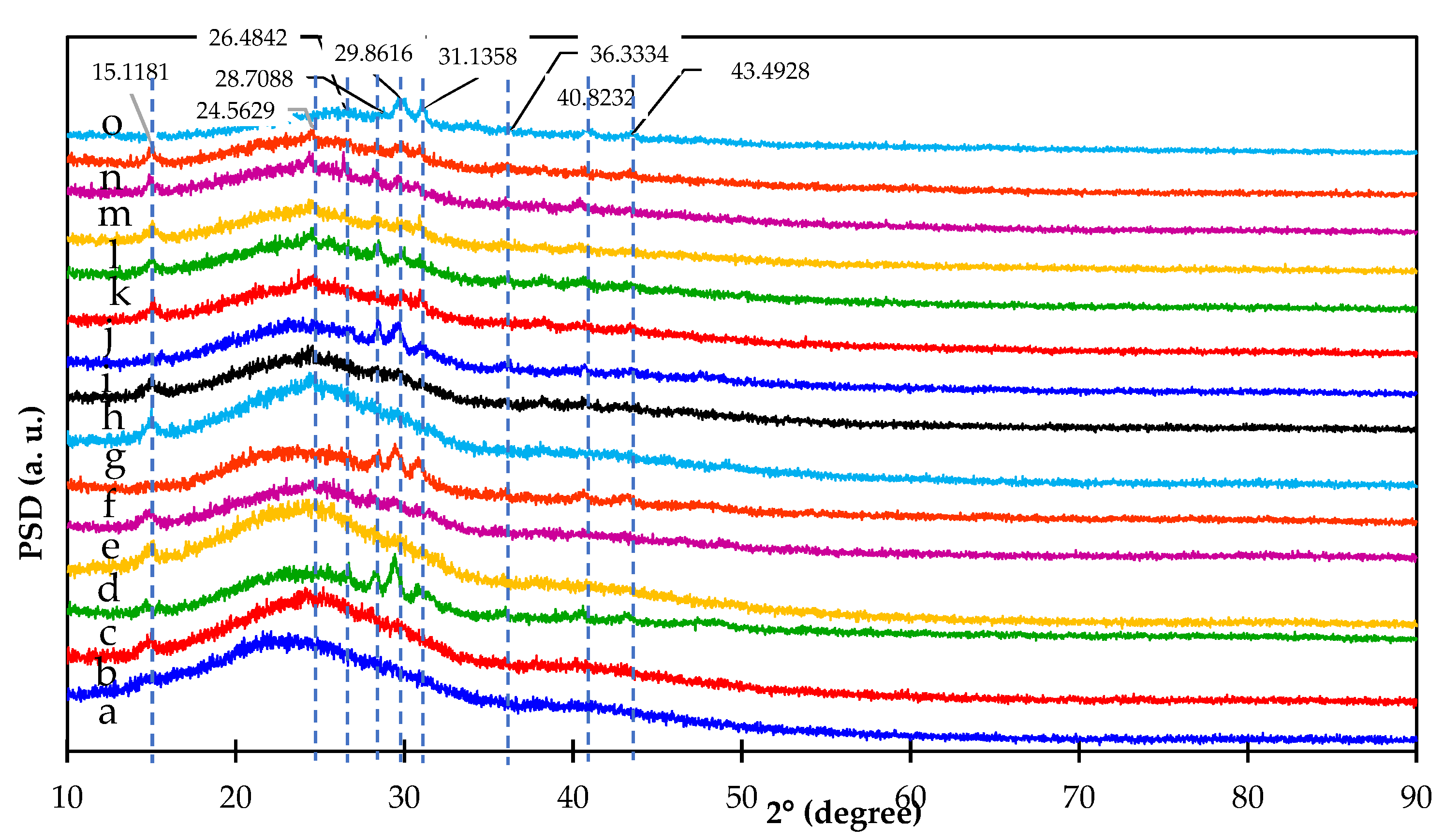
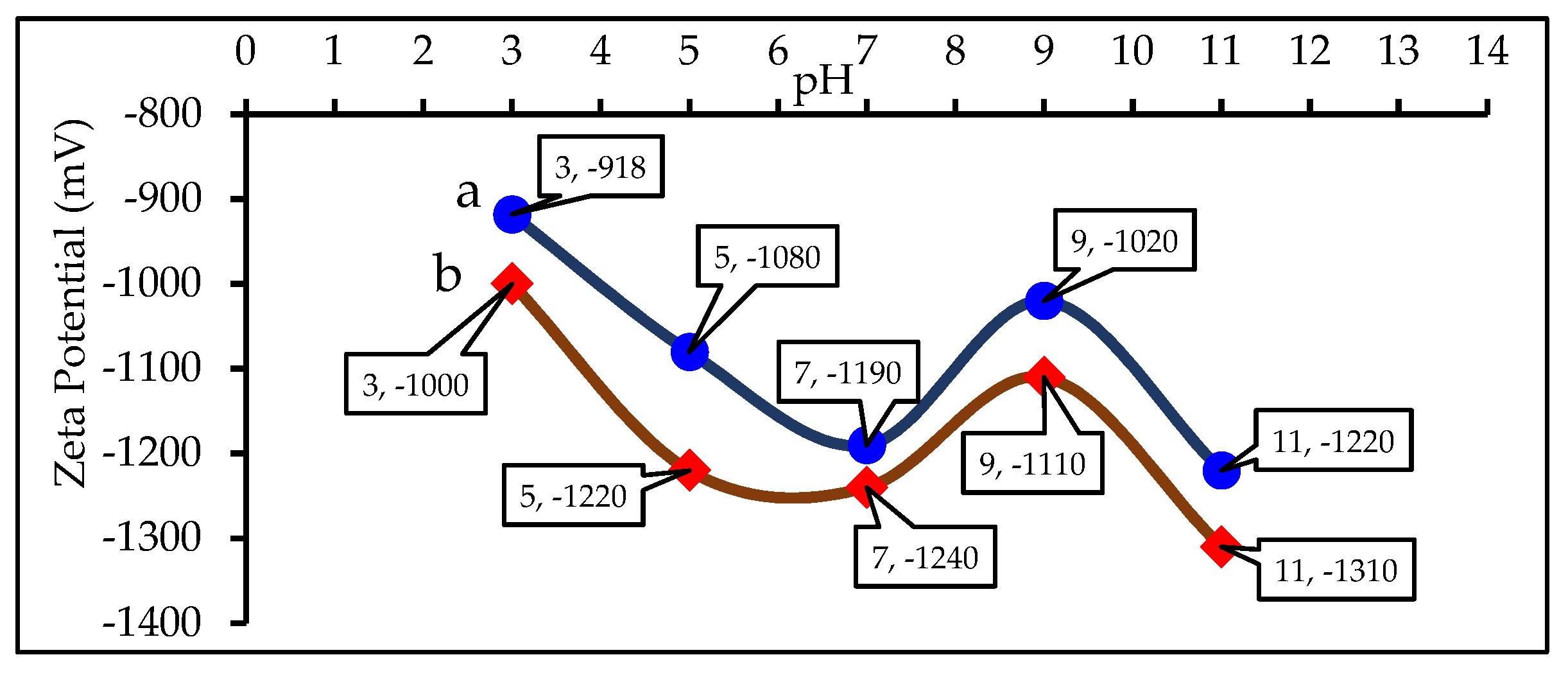
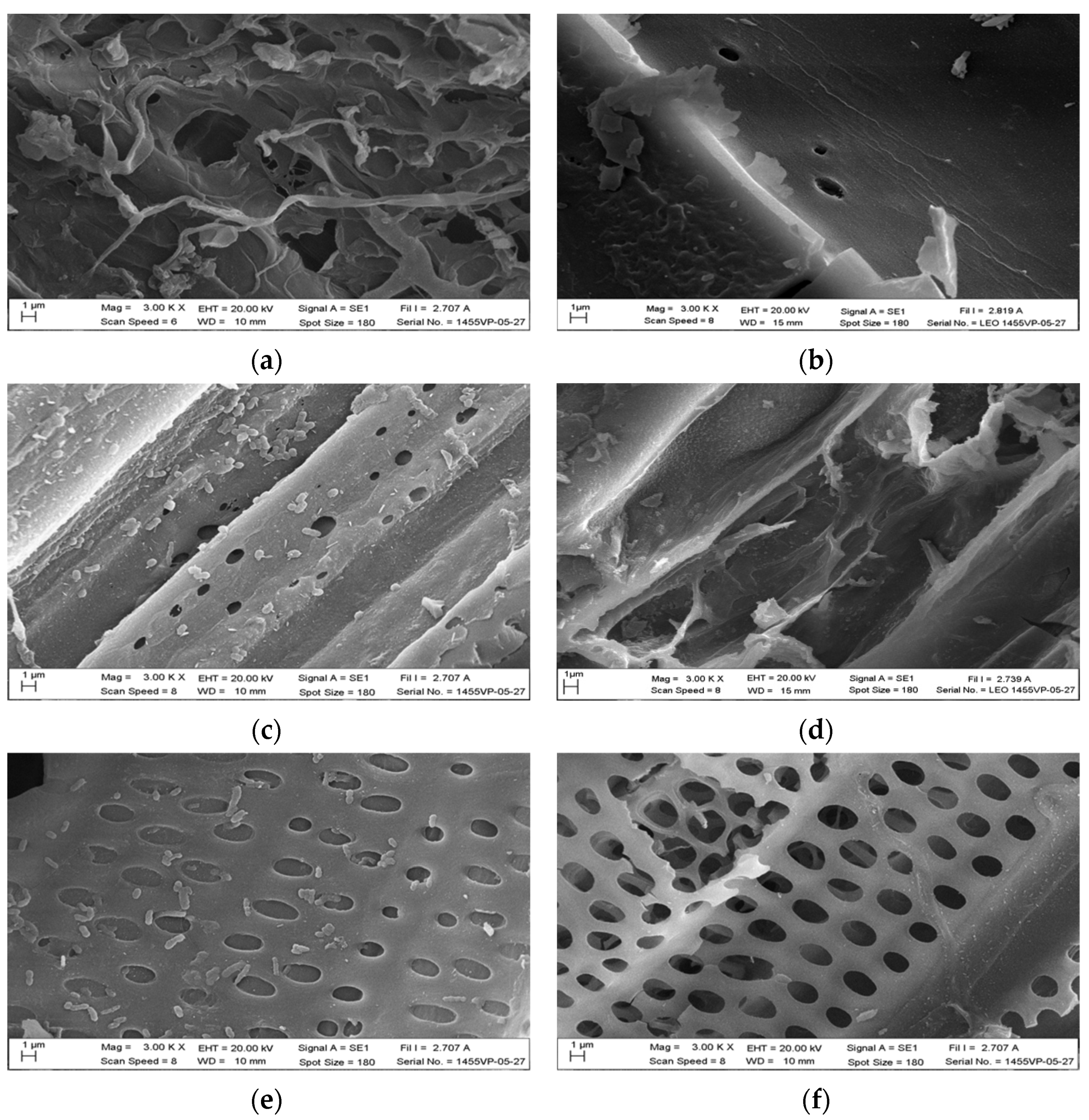
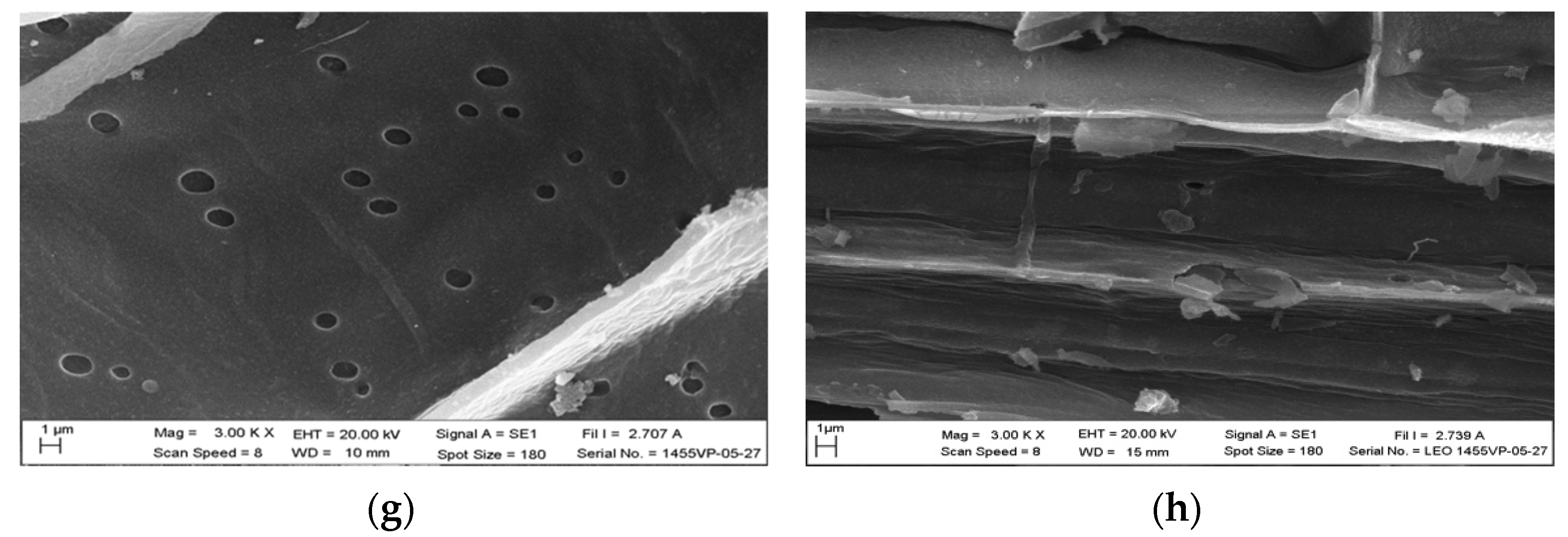
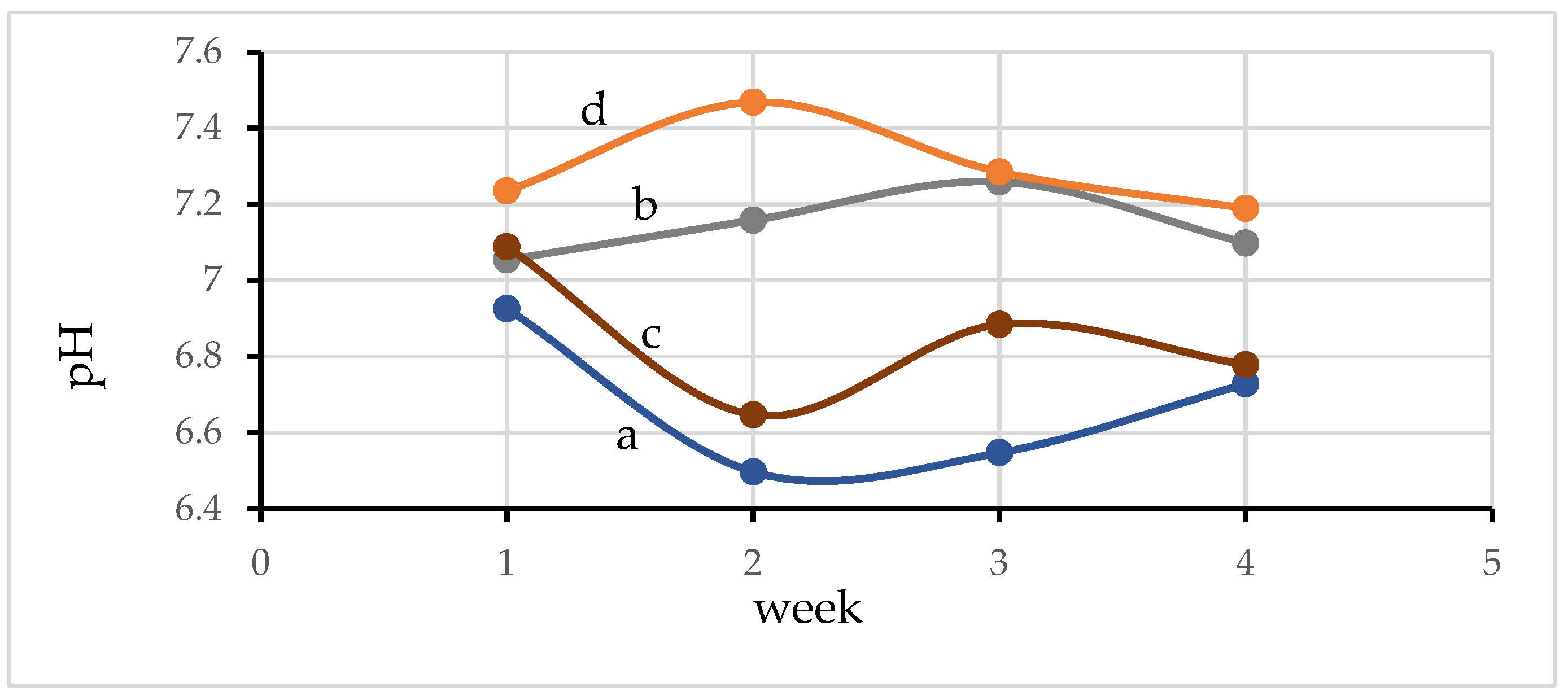
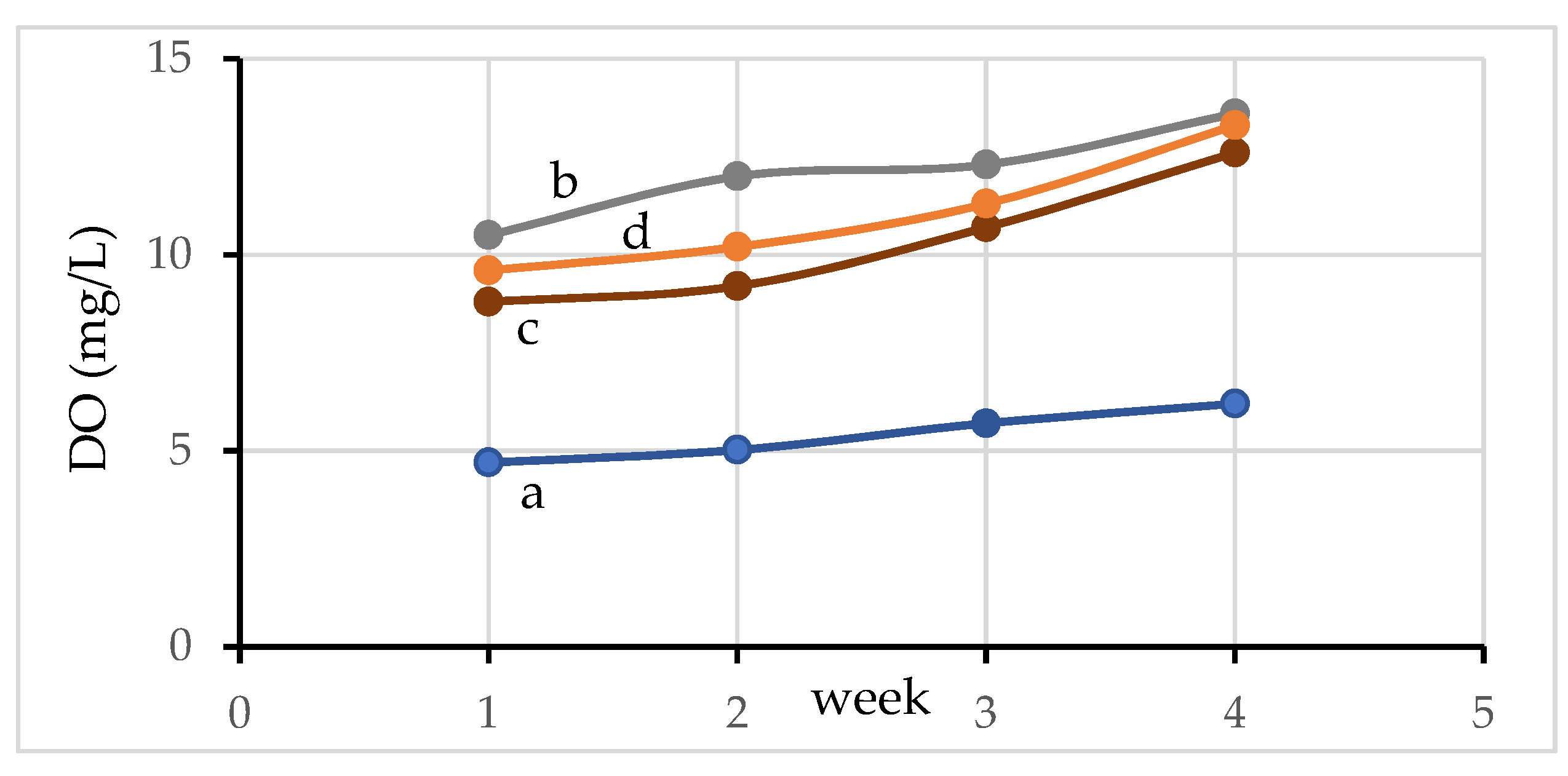
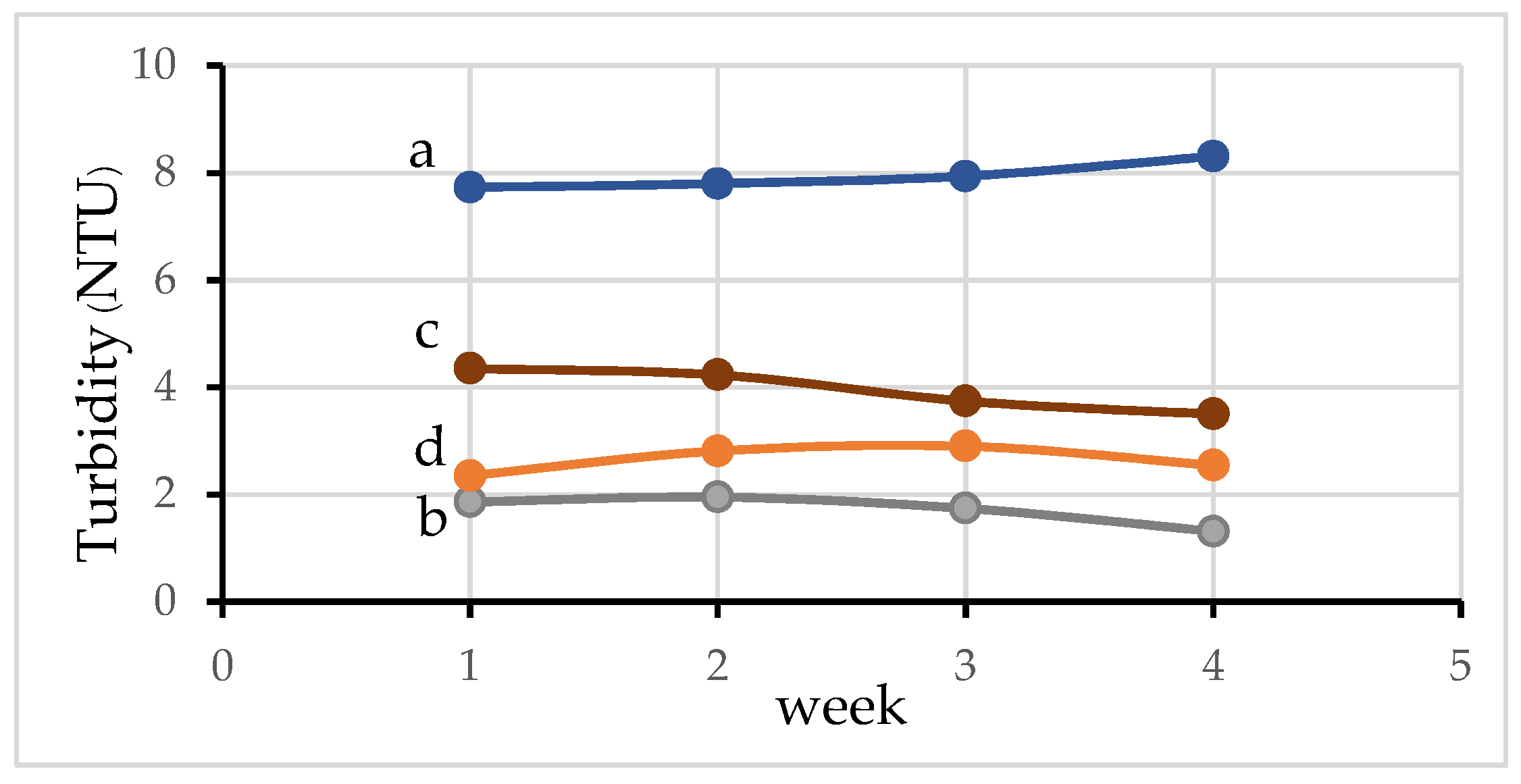
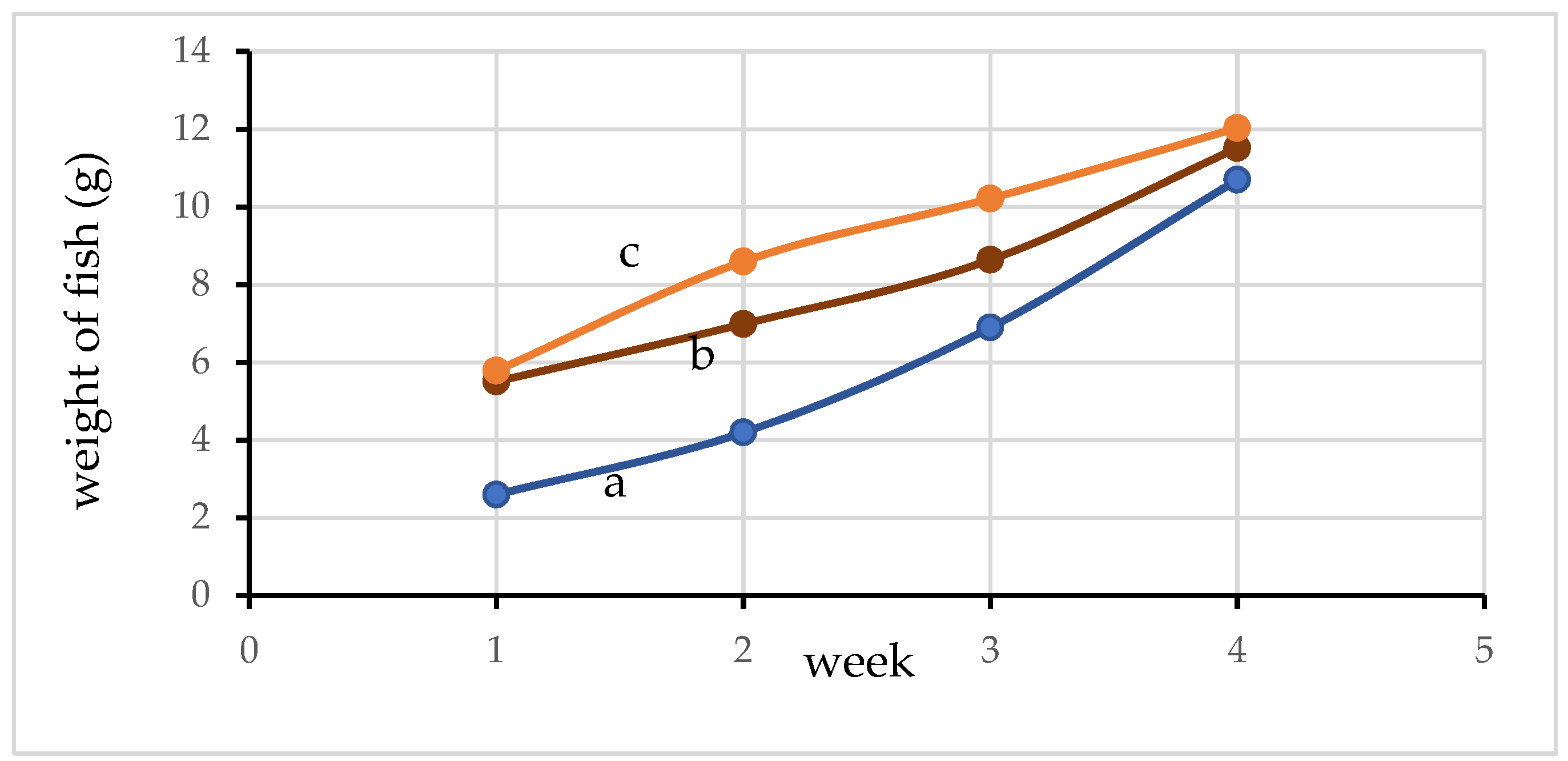
| Temp. (°C) | SLACs * Sample with | Elements Composition (%wt.) | ||||||
|---|---|---|---|---|---|---|---|---|
| C | O | O/C Ratio | Mn | Si | K | Ca | ||
| 300 | w/t HTP | 60.87 | 35.85 | 0.59 | 0.38 | 1.32 | 0.57 | 0.81 |
| 0%KMnO4− HTP | 69.93 | 21.66 | 0.31 | 1.01 | 4.06 | 1.38 | 0.96 | |
| 1%KMnO4− HTP | 62.83 | 27.44 | 0.39 | 1.05 | 4.87 | 2.46 | 1.39 | |
| 3%KMnO4− HTP | 57.45 | 30.67 | 0.53 | 1.26 | 4.87 | 4.23 | 1.45 | |
| 5%KMnO4− HTP | 50.55 | 29.86 | 0.59 | 5.64 | 7.04 | 4.70 | 2.18 | |
| 350 | w/t HTP | 65.52 | 30.85 | 0.47 | 0.67 | 1.83 | 0.32 | 1.01 |
| 0%KMnO4− HTP | 70.69 | 26.10 | 0.37 | 0.45 | 0.58 | 0.59 | 1.27 | |
| 1%KMnO4− HTP | 64.70 | 27.35 | 0.42 | 0.85 | 3.58 | 2.57 | 0.94 | |
| 3%KMnO4− HTP | 61.09 | 28.62 | 0.42 | 1.16 | 5.50 | 2.81 | 1.68 | |
| 5%KMnO4− HTP | 54.15 | 32.23 | 0.60 | 1.90 | 6.53 | 3.27 | 1.93 | |
| 400 | w/t HTP | 68.46 | 28.28 | 0.41 | 0.45 | 1.45 | 0.97 | 1.22 |
| 0%KMnO4− HTP | 75.05 | 20.17 | 0.27 | 0.60 | 1.67 | 1.58 | 1.23 | |
| 1%KMnO4− HTP | 71.68 | 21.29 | 0.30 | 0.66 | 2.43 | 2.54 | 1.40 | |
| 3%KMnO4− HTP | 70.88 | 21.83 | 0.31 | 0.82 | 3.65 | 2.60 | 0.21 | |
| 5%KMnO4− HTP | 59.83 | 26.44 | 0.44 | 1.21 | 7.74 | 3.86 | 0.60 | |
| Temp. (°C) | SLACs * Sample with | BET Surface Area (m2/g) | Surface Area of Pores between 17 Å and 3000 Å (m2/g) | Micropore Volume (cm3/g) | Volume of Pores between 17Å and 3000 Å (cm3/g) |
|---|---|---|---|---|---|
| 300 | w/t HTP | 0.9289 | 0.1997 | 0.000698 | 0.000089 |
| 0%KMnO4− HTP | 2.9560 | 0.9345 | 0.006240 | 0.000921 | |
| 1%KMnO4− HTP | 5.9670 | 3.2251 | 0.003900 | 0.004285 | |
| 3%KMnO4− HTP | 13.5882 | 9.2956 | 0.006700 | 0.013424 | |
| 5%KMnO4 | 7.5572 | 5.8829 | 0.002610 | 0.006508 | |
| 350 | w/t HTP | 10.8815 | 8.8915 | 0.002647 | 0.003702 |
| 0%KMnO4− HTP | 12.1574 | 11.7152 | 0.007006 | 0.011131 | |
| 1%KMnO4− HTP | 15.1145 | 13.6461 | 0.002525 | 0.071490 | |
| 3%KMnO4− HTP | 30.5653 | 26.0662 | 0.004230 | 0.2744 | |
| 5%KMnO4− HTP | 24.8480 | 19.5535 | 0.001575 | 0.16119 | |
| 400 | w/t HTP | 23.7722 | 18.1505 | 0.002759 | 0.18773 |
| 0%KMnO4− HTP | 24.9388 | 21.0224 | 0.005924 | 0.13548 | |
| 1%KMnO4− HTP | 33.3101 | 31.7505 | 0.009794 | 0.14507 | |
| 3%KMnO4− HTP | 45.0364 | 42.4550 | 0.002290 | 0.11473 | |
| 5%KMnO4− HTP | 34.7107 | 32.7012 | 0.002200 | 0.022678 |
| Pond Number | Removal of | |||||
|---|---|---|---|---|---|---|
| NH3 | NO2− | PO43− mg/L | ||||
| mg/L | Removal Rate % | mg/L | Removal Rate % | mg/L | Removal Rate % | |
| 1 | 1.52 | - | 0.41 | - | 0.45 | - |
| Hydroponic | 0.04 | - | 0.02 | - | 0.02 | - |
| 2 | 0.45 | 70.39 | 0.24 | 41.46 | 0.25 | 44.44 |
| 3 | 0.20 | 86.84 | 0.11 | 73.17 | 0.21 | 53.33 |
| Crop Tube Panel Number | Stem Height (cm) | Dried Stem Weight (g/stem) | Root Length (cm) | Dried Root Weight (g/stem) | Number of Leaves/Stem | Dried Leaf Weight (g) | Trunk Diameter (cm) |
|---|---|---|---|---|---|---|---|
| 1 | 15.63 | 1.12 | 9.32 | 0.24 | 9.2 | 0.14 | 16.4 |
| 2 | 16.87 | 1.26 | 10.22 | 0.26 | 9.3 | 0.15 | 16.4 |
| 3 | 16.89 | 1.47 | 11.22 | 0.29 | 9.3 | 0.17 | 17.75 |
Publisher’s Note: MDPI stays neutral with regard to jurisdictional claims in published maps and institutional affiliations. |
© 2022 by the authors. Licensee MDPI, Basel, Switzerland. This article is an open access article distributed under the terms and conditions of the Creative Commons Attribution (CC BY) license (https://creativecommons.org/licenses/by/4.0/).
Share and Cite
Tawatbundit, K.; Mopoung, S. Activated Carbon Preparation from Sugarcane Leaf via a Low Temperature Hydrothermal Process for Aquaponic Treatment. Materials 2022, 15, 2133. https://doi.org/10.3390/ma15062133
Tawatbundit K, Mopoung S. Activated Carbon Preparation from Sugarcane Leaf via a Low Temperature Hydrothermal Process for Aquaponic Treatment. Materials. 2022; 15(6):2133. https://doi.org/10.3390/ma15062133
Chicago/Turabian StyleTawatbundit, Kanyanat, and Sumrit Mopoung. 2022. "Activated Carbon Preparation from Sugarcane Leaf via a Low Temperature Hydrothermal Process for Aquaponic Treatment" Materials 15, no. 6: 2133. https://doi.org/10.3390/ma15062133
APA StyleTawatbundit, K., & Mopoung, S. (2022). Activated Carbon Preparation from Sugarcane Leaf via a Low Temperature Hydrothermal Process for Aquaponic Treatment. Materials, 15(6), 2133. https://doi.org/10.3390/ma15062133







